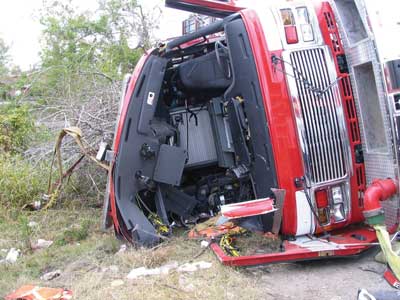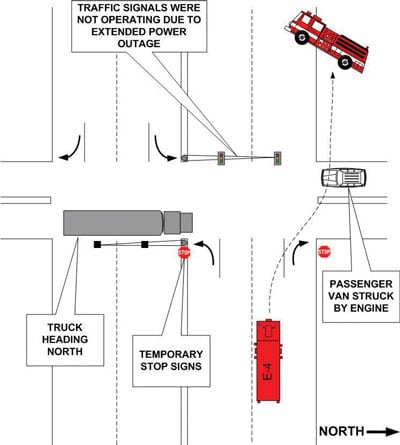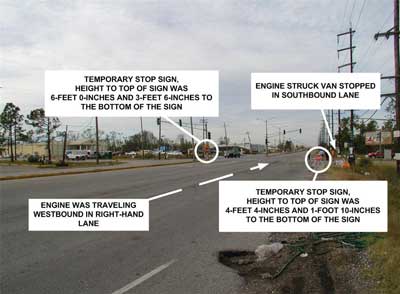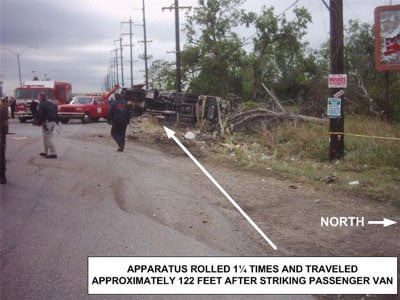Career Captain Dies and the Driver/Operator and a Fire Fighter are Severely Injured in Apparatus Crash - Louisiana
 Death in the Line of Duty…A summary of a NIOSH fire fighter fatality investigation
Death in the Line of Duty…A summary of a NIOSH fire fighter fatality investigation
F2005-35 Date Released: October 20, 2006
SUMMARY
On December 2, 2005, a male career Captain (the victim) died, and a male driver/operator and a male fire fighter suffered severe injuries when their apparatus struck a passenger van at a four-way intersection, left the road and overturned 1¼ times. The crew was responding Code 3 (lights and sirens) to a reported gas leak when the incident occurred. The permanent stop lights had been replaced by temporary traffic control stop signs at the intersection as a result of an extended power outage caused by Hurricane Katrina. NIOSH investigators concluded that, to minimize the risk of similar occurrences, fire departments should:
- provide members with safety advisories highlighting hazardous situations that may be encountered while responding to, working on the scene, or returning from emergency calls
- provide refresher training on and enforce standard operating procedures (SOPs) for emergency vehicle operations, including the use of seatbelts
- ensure that drivers of emergency apparatus come to a complete stop at intersections having a stop sign or a red signal light before proceeding through the intersection
In addition,
- State and local authorities having responsibility over local roadways should ensure that temporary traffic control devices and traffic control signals are in compliance with the standards set forth in the Manual on Uniform Traffic Control Devices (MUTCD).
 |
|
Photo courtesy of fire department
|
INTRODUCTION
On December 2, 2005, a 33-year-old male career Captain (the victim) died when the apparatus he was riding in was involved in a crash at an intersection during an emergency response. The apparatus driver/operator and another fire fighter were also severely injured in the crash. On December 6, 2005, the U.S. Fire Administration notified the National Institute for Occupational Safety and Health (NIOSH) of this incident. On December 12, 2005, two Safety and Occupational Health Specialists from the NIOSH Fire Fighter Fatality Investigation and Prevention Program investigated this incident. A meeting was conducted with the Chief Officers assigned by the department to work on this incident, local representatives from the International Association of Fire Fighters and a city attorney. An interview was conducted with the driver of the apparatus. The investigators reviewed the driver/operator’s training records and the victim’s training records, autopsy report and death certificate. NIOSH investigators also reviewed the city police department’s report, the fire department’s standard operating procedures (SOPs) on emergency vehicle operations, the department’s report on this incident, maps and photos provided by the fire department and witness statements. The incident site was visited and photographed.
Fire Department
This career department consisted of 740 uniformed fire fighters in 32 stations that served a population of about 450,000 in a geographic area of approximately 135 square miles, prior to August 29, 2005. The fire department is located in a city that suffered extensive damages as a result of Hurricane Katrina. A number of fire department stations were either closed or had reduced capabilities as a result of the hurricane.
Training/Experience
The victim had 13 years of experience with this fire department and had completed an extensive list of training courses which included: Fire Suppression and Tactics, Building Construction and Firefighter Safety, Driver/Operator and Defensive Driving.
The driver/operator had completed 14 training sessions (28 hours) of driver training with this fire department between June 2002 and August 2005.
Equipment and Personnel
1310 hours – Initial dispatch for report of possible gas leak included: Engine 4 (Captain [victim], driver/operator and a fire fighter).
1319 hours – Dispatch of emergency medical service (EMS) unit for the motor vehicle incident involving Engine 4: Ambulance 6218.
1321 hours – Additional EMS units dispatched: Ambulance 6210, Ambulance 6216, Ambulance 6232 and Ambulance 6215.
1324 hours – Engine 36 and Ladder 13 dispatched to assist with Engine 4 incident.
Apparatus
The 2004 engine involved in this incident was approximately 38 feet long, 8 feet wide, and 9 feet high, with a gross vehicle weight rating of 51,000 pounds (21,000 gross axle weight rating for the front and 30,000 gross axle weight rating for the rear). The vehicle had two axles with six tires (two in the front and four in the rear). It had a rectangular-shaped, 500-gallon baffled water tank that was filled to capacity at the time of the incident. The engine had an automatic transmission, an air braking system, and 3-point safety belts for all riding positions.
Road and Weather Conditions
The engine was traveling westbound on a four-lane blacktop roadway with two lanes that measured approximately 50 feet in width on each side of a median. The posted speed limit was 45 miles per hour (mph). The incident occurred in an intersection where the street lights had been replaced with temporary stop signs due to the extended power outage caused by Hurricane Katrina. Note: The hurricane made its landfall on August 29th, 2005. There were stop signs posted on the left and right sides of the road in each of the four directions. Height measurements, from ground level to the top and bottom of the stop signs, were taken by the investigators. The stop sign on the left-hand side of the westbound lane measured 6-feet 0-inches to the top of the sign and 3-feet 6-inches to the bottom of the sign. The stop sign on the right-hand side of the road measured 4-feet 4-inches to the top of the sign and 1-foot 10-inches to the bottom of the sign (Photo 1 and Diagram). The road was dry and the weather conditions were cloudy with temperatures in the low fifties.
INVESTIGATION
Engine 4 was dispatched at 1310 hours to a reported gas leak. Engine 4 was responding with lights and sirens (Code 3), heading westbound on a four-lane roadway. The driver/operator reported to NIOSH investigators that he was traveling at the posted speed limit (45 miles per hour) when he approached and entered the intersection. The engine was traveling in the right-hand travel lane and was nearing the intersection when the Captain (victim) yelled for the driver/operator to “watch out” as a tractor trailer truck was entering the intersection from their left (from the south) (Photo1 and Diagram). The driver/operator steered the apparatus to the right in order to avoid the tractor trailer. The apparatus traveled over the concrete median (6 to 8-inches in height) between the north and southbound lanes before striking the front end of a passenger van stopped in the southbound lane. The engine continued traveling in a westbound direction and into a ditch that caused the apparatus to overturn an estimated 1¼ times before coming to rest on the passenger’s side of the vehicle (Photo2). The driver/operator and victim were ejected from the apparatus and the fire fighter was trapped in the cab. Note: The occupants of Engine 4 were not wearing their seatbelts at the time of the incident.
Emergency medical services (EMS [Ambulance 6218]) were dispatched to the scene at 1319 hours. Ambulance 6218 arrived on the scene at approximately 1320 hours and requested additional EMS (Ambulance Units 6210, 6216, 6232 and 6215) for the injured fire fighters and the two civilians in the passenger van. Engine 36 and Ladder 13 were dispatched at 1324 hours to assist at the incident scene.
Engine 36 arrived on the scene at approximately 1328 hours and found the driver/operator lying in the road approximately 20 feet directly in front of the engine. The driver/operator had been ejected through the front window. The driver/operator was treated on the scene and transported in Ambulance 6216 to an area hospital. The victim was found pinned under the apparatus and pronounced dead on the scene. He was then extricated from underneath the apparatus and transported to an area hospital. The fire fighter riding in the seat behind the victim was trapped in the cab and had to be extricated before being transported to an area hospital at approximately 1354 hours in Ambulance 6215.
Cause of Death
The autopsy report listed the victim’s cause of death as multiple blunt force trauma and compressed asphyxiation.
INJURIES
The driver/operator suffered injuries to his head, hip, back and legs. The fire fighter riding behind the victim suffered injuries to his neck, back and a leg.
RECOMMENDATIONS/DISCUSSIONS
Recommendation #1: Fire departments should provide members with safety advisories highlighting hazardous situations that may be encountered while responding to, working on the scene, or returning from emergency calls.
Discussion: Fire departments should continually work to identify actual and potential hazards associated with fire department operations. The fire departments should then highlight their findings and adopted solutions in a safety advisory or bulletin that is shared with all fire department members. This can be accomplished as part of the risk management program or plan. The National Fire Protection Association’s, NFPA 1500 Standard on fire department occupational safety and health program,1 outlines the requirements for a risk management plan in section 4.2. The risk management plan should cover the risks associated with vehicle operations, both emergency and non-emergency. Fire departments employing a risk management plan should identify actual and potential hazards; evaluate the likely occurrence of a given hazard; and provide and implement the best solutions for the elimination or mitigation of those identified potential hazards.1
The destruction and devastation resulting from Hurricane Katrina posed new hazards and challenges for the emergency responders from the fire department involved in this incident. Extended power outages, downed power lines, closed fire stations, longer response distances and times, and new traffic patterns presented the fire department with the responsibility of ensuring that all members were aware of these hazards and that the members followed established or recently adopted departmental procedures. This can be accomplished by including fire fighters in daily safety briefings, email notifications and postings in fire stations and the fire department’s headquarters.
Recommendation #2: Fire departments should provide refresher training on and enforce standard operating procedures (SOPs) for emergency vehicle operations, including the use of seatbelts.
Discussion: Fire departments should provide refresher training on and enforce their standard operating procedures (SOPs) regarding emergency vehicle operations and use of seat belts. The fire department’s SOPs and emergency vehicle operations manual require that all persons riding in all emergency vehicles be seated and secured in an approved riding position anytime the vehicle is in motion.2, 3 An operator who is properly secured by a seatbelt will have a better chance at maintaining control of the vehicle in an emergency situation and surviving a crash.3 The U.S. Fire Administration’s Safe operation of fire tankers states “Some crash reconstruction specialists have speculated that particular incidents may have occurred after the unrestrained driver of a truck was bounced out of an effective driving position following the initial contact with a bump in the road or another object.”4
The U.S. Fire Administration’s Emergency vehicle safety initiative recommends that fire departments “require units to come to a complete stop at red lights, stop signs, and activated or unguarded rail crossings before proceeding.”5 The rules and regulations section of the emergency vehicle operations manual included the following: “When responding, a fire apparatus approaching a traffic signal showing red, a “stop” sign or a “yield” sign, the apparatus shall stop and not proceed until all other vehicles yield the right of way. If the right is not given, it shall not be taken under any condition.”3
Refresher training provides the fire department with an opportunity to ensure that all members are familiar with current SOPs. It is important for officers to ensure that all members are following the established policy.
Recommendation #3: Fire departments should ensure that drivers of emergency apparatus come to a complete stop at intersections having a stop sign or a red signal light before proceeding through the intersection.
Discussion: The International Fire Service Training Association’s Pumping apparatus driver/operator handbook states “Sound defensive driving skills are one of the most important aspects of safe driving. When approaching an intersection, the driver/operator should slow the apparatus to a speed that allows a stop at the intersection if necessary. Even if faced with a green light or no signal at all, the apparatus should be brought to a complete stop if there are any obstructions, such as buildings or trucks that block the driver/operator’s view of the intersection. Depending on the motor vehicle statutes and departmental SOPs within a particular jurisdiction, fire apparatus on an emergency response may proceed through a red traffic signal or stop sign after coming to a complete stop and assuring that all lanes of traffic are accounted for and yielding to the apparatus. Do not proceed into the intersection until you are certain that every other driver sees you and is allowing you to proceed. Simply slowing when approaching an intersection and then coasting through is not an acceptable substitute for coming to a complete stop.”6
In addition,
Recommendation #4: State and local authorities having responsibility over local roadways should ensure that temporary traffic control devices and traffic control signals are in compliance with the standards set forth in the Manual on Uniform Traffic Control Devices (MUTCD).
Discussion: State and local authorities having responsibility over roadways should ensure that temporary traffic control devices are placed in compliance with Sections 2A.18 and 4D.01 of the Manual on Uniform Traffic Control Devices (MUTCD). The MUTCD requires signs installed at the sides of roadways to be at least 5 ft high, measured from the bottom of the sign to the near edge of the pavement.7 The temporary traffic control devices (STOP signs) were mounted at various heights, some below and some above the minimum height set by the MUTCD, at the intersection where the incident occurred. The traffic control signals were not operating at the time of the incident due to an extended power outage.
REFERENCES
- 1. NFPA [2002]. NFPA 1500: Standard on fire department occupational safety and health program. Quincy, MA: National Fire Protection Association.
- Louisiana fire department [1995]. Standard operating procedures (SOPs).
- Louisiana fire department [2005]. Emergency vehicle operations manual.
- U.S. Fire Administration [2004]. Safe operation of fire tankers. Emmitsburg, MD. Federal Emergency Management Agency FA-248.
- U.S. Fire Administration [2004]. Emergency vehicle safety initiative. Emmitsburg, MD. Federal Emergency Management Agency FA-272.
- International Fire Service Training Association [1999]. Pumping apparatus driver/operator handbook. Stillwater, OK: Oklahoma State University. pp. 59-60.
- FHWA [2003]. Manual on uniform traffic control devices millennium edition. Washington, DC: U.S. Department of Transportation, Federal Highway Administration (FHWA).
INVESTIGATOR INFORMATION
This incident was investigated by Mark McFall and Jay Tarley, Safety and Occupational Health Specialists, Surveillance and Field Investigations Branch, Division of Safety Research, NIOSH. The report was written by Mark McFall.
Photograph and Diagram

|
|
Diagram. Aerial view of incident scene |

|

|
|
Photo 2. View of incident scene. Photo courtesy of fire department
|
This page was last updated on 11/08/06.
